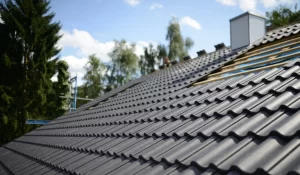Types of Roof Covering Materials

Roof covering materials are a vital part of a pitched roof, and they protect the roof framework from the elements. Asbestos cement sheets are one such option, and they are made of an amalgamation of cement and pulverized asbestos. Asbestos cement sheets are lightweight, fire-resistant, and affordable. Unlike other roofing materials, asbestos cement sheets do not degrade or rot.
Roof covering materials can be UL-certified if they pass the UL standards. This is the oldest and most commonly used roofing standard. This standard sets minimum requirements for a roof assembly’s fire resistance, and it uses a classification system to identify successful and unsuccessful assemblies. In addition, the UL listing mark signifies that the manufacturer represents that the product is safe and does not pose any foreseeable hazards.
Another popular roofing material is tile. Tiles are available in a variety of sizes and shapes. They are named after their region of origin. Plain tiles, for example, are square or rectangular, and are commonly 25 to 35 cm long. Their thickness is typically between nine and fifteen millimeters. They require the use of groundwork to attach them to the battens.
Regardless of the type of roof covering materials you choose, you must maintain it to ensure it stays in good condition. Over time, exposure to harmful environmental factors such as high wind and rain can deteriorate a roof. However, there are some basic maintenance procedures that can help extend the life of your roof and prevent damage to its components.
One of the oldest roof covering materials is clay tiles. These are manufactured in a similar way to bricks and have several types. Some types of clay tiles include flat tiles, pantiles, half-round country tiles, and pot tiles. In addition to clay tiles, concrete tiles are sometimes used for roof covering. However, their usage is limited due to their high price and difficulty in manufacture.
Another option for roof coverings is metal. Metal can provide a similar look to other common roofing materials while providing excellent fire resistance, thermal sequestration, and sound insulation. It is also cheaper than other types and can last up to 50 years with proper maintenance. In addition, metal roofs are more durable and can withstand harsh weather conditions.
Another common option for roof coverings is rolled asphalt. These are similar to asphalt shingles, but are applied to the roof in layers. On top of that, small crushed stones are glued to the surface to provide additional UV protection. Although glass is a long-standing roof covering material, it does have its disadvantages. Glass roofs require highly trained labours to install them. Additionally, industrial vibration can damage the glass roofing. Compared to asphalt and other roofing materials, glass roofs are quite expensive.
Thatch is a traditional roof covering material used in some countries. Asbestos cement sheets are easy to maintain and clean, but can be expensive. However, it is an environmentally-friendly option for roofing and can provide a cool and comfortable home during hot weather.








